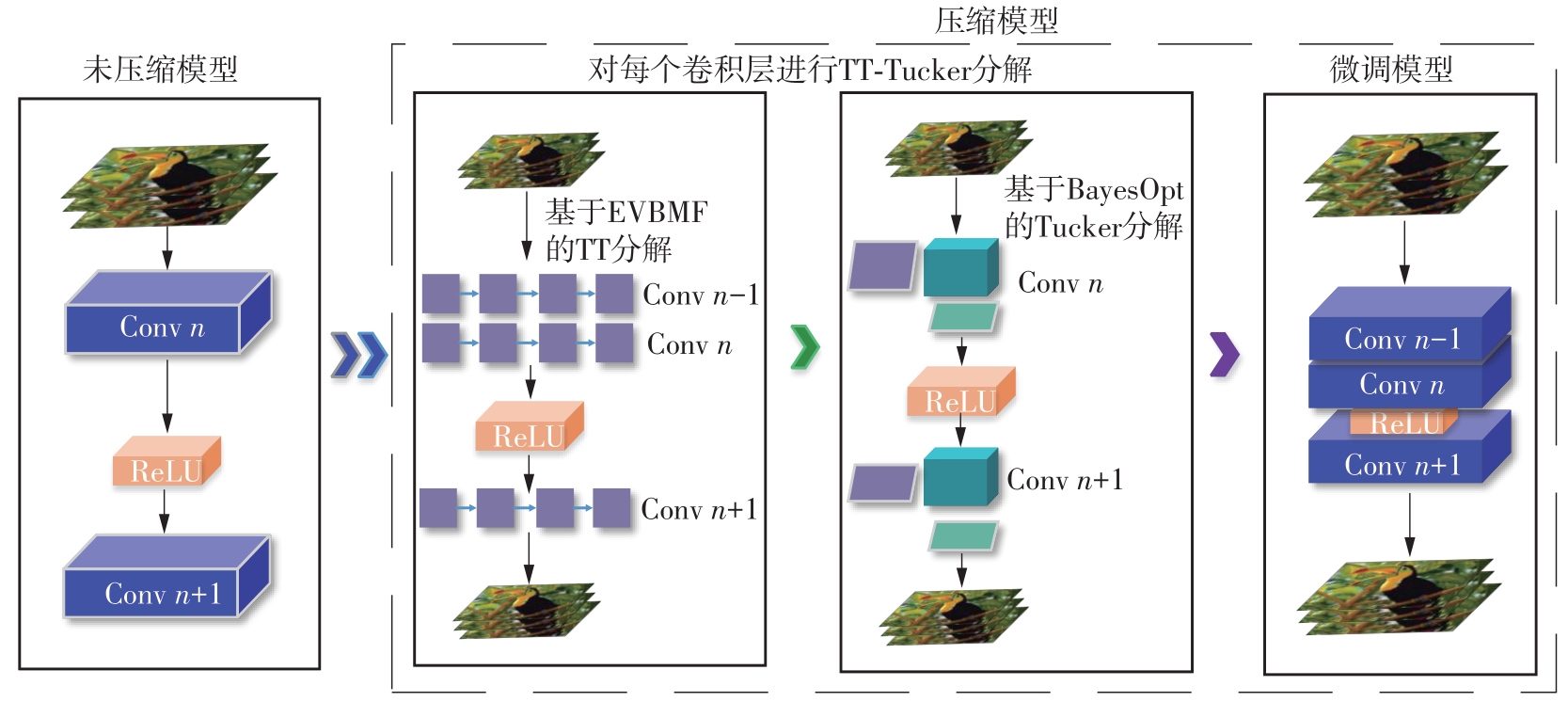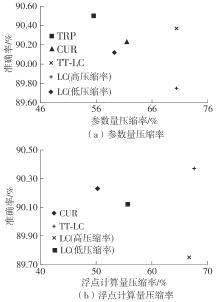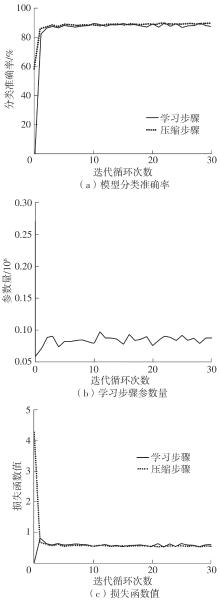Journal of South China University of Technology(Natural Science Edition) ›› 2024, Vol. 52 ›› Issue (7): 29-38.doi: 10.12141/j.issn.1000-565X.230617
• Electronics, Communication & Automation Technology • Previous Articles Next Articles
A TT-Tucker Decomposition-Based LC Convolutional Neural Network Compression Method Without Pre-Training
LIU Weirong( ), ZHANG Zhiqiang, ZHANG Ning, MENG Jiahao, ZHANG Min, LIU Jie(
), ZHANG Zhiqiang, ZHANG Ning, MENG Jiahao, ZHANG Min, LIU Jie( )
)
- College of Electrical and Information Engineering,Lanzhou University of Technology,Lanzhou 730050,Gansu,China
-
Received:2023-10-07Online:2024-07-25Published:2024-02-02 -
Contact:刘婕(1978—),女,硕士,工程师,主要从事工业过程先进控制方法与应用研究。 E-mail:ljdaisy@163.com -
About author:刘微容(1976—),男,博士,教授,博士生导师,主要从事工业过程先进控制理论与应用、图像处理与模式识别研究。E-mail: liuwr@lut.edu.cn -
Supported by:the National Natural Science Foundation of China(62261032);the Natural Science Foundation of Gansu Province(22JR5RA272);the Key Talent Project of Gansu Province
CLC Number:
Cite this article
LIU Weirong, ZHANG Zhiqiang, ZHANG Ning, MENG Jiahao, ZHANG Min, LIU Jie. A TT-Tucker Decomposition-Based LC Convolutional Neural Network Compression Method Without Pre-Training[J]. Journal of South China University of Technology(Natural Science Edition), 2024, 52(7): 29-38.
share this article
Table 1
Experimental results of several methods with ResNet32 network on CIFAR10 dataset"
| 方法 | C/106 | γc /% | F/106 | γf /% | A/% | |
|---|---|---|---|---|---|---|
| 无压缩 | 0.46 | 0.0 | 68.86 | 0.0 | 92.49 | |
| LC(低压缩) | 1.0×10-4 | 0.25 | 45.7 | 36.09 | 47.6 | 92.21 |
| PSTRN-S | 0.18 | 60.9 | 91.44 | |||
| LC(高压缩) | 1.5×10-4 | 0.17 | 63.0 | 27.01 | 60.8 | 91.62 |
| LC-LR | 4.0×10-4 | 0.15 | 67.4 | 23.26 | 66.2 | 91.46 |
| CUR | 0.18 | 60.9 | 37.84 | 45.0 | 90.64 | |
| TT-LC | 5.0×10-6 | 0.14 | 69.6 | 22.93 | 66.7 | 92.22 |
Table 2
Experimental results of several methods with ResNet56 network on CIFAR10 dataset"
| 方法 | C/106 | γc /% | F/106 | γf /% | A/% | |
|---|---|---|---|---|---|---|
| 无压缩 | 0.85 | 0.0 | 125.49 | 0.0 | 93.03 | |
| PF-B | 0.73 | 14.1 | 90.90 | 27.6 | 93.06 | |
| NISP | 0.36 | 57.6 | 70.76 | 43.6 | 93.01 | |
| AMC | 62.75 | 50.0 | 91.90 | |||
| ENC | 62.75 | 50.0 | 93.00 | |||
| CP | 62.75 | 50.0 | 91.80 | |||
| TRP | 0.35 | 58.8 | 92.63 | |||
| KSE | 0.36 | 57.6 | 50.20 | 60.0 | 92.88 | |
| LC | 1.0×10-4 | 0.38 | 55.3 | 45.60 | 63.7 | 91.80 |
| LC-LR | 4.0×10-4 | 0.28 | 67.1 | 41.83 | 66.7 | 92.54 |
| CUR | 0.37 | 56.5 | 80.44 | 35.9 | 91.58 | |
| TT-LC | 5.0×10-6 | 0.26 | 69.4 | 41.73 | 66.7 | 93.06 |
Table 5
Comparison of experimental results with or without TT decomposition and automatic rank selection by Bayes rule"
| 方法 | A/% | C/106 | γc /% | F/106 | γf /% |
|---|---|---|---|---|---|
| 无压缩 | 91.25 | 0.27 | 0.0 | 40.6 | 0.0 |
| LC-Tucker(高压缩率) | 89.91 | 0.08 | 70.4 | 13.8 | 66.0 |
| LC-Tucker(低压缩率) | 90.23 | 0.09 | 66.7 | 14.4 | 64.5 |
| TT-LC(no-BayesOpt) | 90.32 | 0.09 | 66.7 | 14.7 | 63.8 |
| TT-LC(固定秩为22) | 89.08 | 0.08 | 70.4 | 15.1 | 62.8 |
| TT-LC | 90.37 | 0.08 | 70.4 | 13.1 | 67.7 |
| 1 | PUNYANI P, GUPTA R, KUMAR A .Neural networks for facial age estimation:a survey on recent advances[J].Artificial Intelligence Review,2020,53(5):3299-3347. |
| 2 | SU N, CHEN X, GUAN J,et al .Maritime target detection based on radar graph data and graph convolutional network[J].IEEE Geoscience and Remote Sensing Letters,2022,19:4019705/1-5. |
| 3 | CONG S, ZHOU Y .A review of convolutional neural network architectures and their optimizations[J].Artificial Intelligence Review,2022,56(3):1905-1969. |
| 4 | 高晗,田育龙,许封元,等 .深度学习模型压缩与加速综述[J].软件学报,2021,32(1):68-92. |
| GAO Han, TIAN Yu-long, XU Feng-yuan,et al .Survey of deep learning model compression and acceleration[J].Journal of Software,2021,32(1):68-92. | |
| 5 | IDELBAYEV Y, CARREIRA-PERPIÑÁN M Á .Low-rank compression of neural nets:learning the rank of each layer[C]∥ Proceedings of 2020 IEEE/CVF Conference on Computer Vision and Pattern Recognition.Seattle:IEEE,2020:8046-8056. |
| 6 | 魏钰轩,陈莹 .基于自适应层信息熵的卷积神经网络压缩[J].电子学报,2022,50(10):2398-2408. |
| WEI Yu-xuan, CHEN Ying .Convolutional neural network compression based on adaptive layer entropy[J].Acta Electronica Sinica,2022,50(10):2398-2408. | |
| 7 | WU J, CONG L, WANG Y,et al .Quantized convolutional neural networks for mobile devices[C]∥ Proceedings of 2016 IEEE Conference on Computer Vision and Pattern Recognition.Seattle:IEEE,2016:4820-4828. |
| 8 | JI M, SHIN S, HWANG S,et al .Refine myself by teaching myself:feature refinement via self-knowledge distillation[C]∥ Proceedings of 2021 IEEE/CVF Conference on Computer Vision and Pattern Recognition.Nashville:IEEE,2021:10659-10668. |
| 9 | ELSKEN T, METZEN J H, HUTTER F .Neural architecture search:a survey[J].Journal of Machine Learning Research,2019,20:1997-2017. |
| 10 | LEBEDEV V, GANIN Y, RAKHUBA M,et al .Speeding-up convolutional neural networks using fine-tuned CP-decomposition[C]∥ Proceedings of the 3rd International Conference on Learning Representations.San Diego:OpenReview.net,2015:1-11. |
| 11 | NOVIKOV A, PODOPRIKHIN D, OSOKIN A,et al .Tensorizing neural networks[C]∥ Proceedings of the 28th International Conference on Neural Information Processing Systems.Montreal:ACM,2015:442-450. |
| 12 | WANG W, SUN Y, ERIKSSON B,et al .Wide compression:tensor ring nets[C]∥ Proceedings of 2018 IEEE/CVF Conference on Computer Vision and Pattern Recognition.Salt Lake City:IEEE,2018:9329-9338. |
| 13 | KIM Y D, PARK E, YOO S,et al .Compression of deep convolutional neural networks for fast and low power mobile applications[C]∥ Proceedings of the 4th International Conference on Learning Representations.San Juan:OpenReview.net,2016:576-584. |
| 14 | NAKAJIMA S, SUGIYAMA M, BABACAN S D,et al .Global analytic solution of fully-observed variational Bayesian matrix factorization[J].Journal of Machine Learning Research,2013,14(1):1-37. |
| 15 | KIM T, LEE J, CHOE Y .Bayesian optimization-based global optimal rank selection for compression of convolutional neural networks[J].IEEE Access,2020,8:17605-17618. |
| 16 | KOLDA T G, BADER B W .Tensor decompositions and applications[J].SIAM Review,2009,51(3):455-500. |
| 17 | CHENG Z, LI B, FAN Y,et al .A novel rank selection scheme in tensor ring decomposition based on reinforcement learning for deep neural networks[C]∥ Proceedings of 2020 IEEE International Conference on Acoustics,Speech and Signal Processing.Barcelona:IEEE,2020:3292-3296. |
| 18 | LI N, PAN Y, CHEN Y,et al .Heuristic rank selection with progressively searching tensor ring network[J].Complex & Intelligent Systems,2022,8:771-785. |
| 19 | BESAG J .On the statistical-analysis of dirty pictures[J].Journal of the Royal Statistical Society Series B:Methodological,1986,48(3):259-302. |
| 20 | CAI G Y, LI J H, LIU X X,et al .Learning and compressing:low-rank matrix factorization for deep neural network compression[J].Applied Sciences,2023,13:2704/1-22. |
| 21 | XU Y, LI Y, ZHANG S,et al .Traned rank pruning for efficient deep neural networks[C]∥ Proceedings of 2019 the Fifth Workshop on Energy Efficient Machine Learning and Cognitive Computing-NeurIPS Edition.Vancouver:IEEE,2019:14-17. |
| 22 | HE Y, ZHANG X, SUN J .Channel pruning for accele-rating very deep neural networks[C]∥ Proceedings of 2017 IEEE International Conference on Computer Vision.Venice:IEEE,2017:1398-1406. |
| 23 | HE Y, LIN J, LIU Z,et al .AMC:autoML for model compression and acceleration on mobile devices[C]∥ Proceedings of the 15th European Conference on Computer Vision.Munich:Springer,2018:815-832. |
| 24 | LI H, KADAV A, DURDANOVIC I,et al .Pruning filters for efficient ConvNets[C]∥ Proceedings of the 5th International Conference on Learning Representations.Toulon:OpenReview.net,2017:1-13. |
| 25 | YU R, LI A, CHEN C F,et al .NISP:pruning networks using neuron importance score propagation[C]∥ Proceedings of 2018 IEEE/CVF Conference on Computer Vision and Pattern Recognition.Salt Lake City:IEEE,2018:9194-9203. |
| 26 | KIM H, KHAN M U K, C-M KYUNG .Efficient neural network compression[C]∥ Proceedings of 2019 IEEE/CVF Conference on Computer Vision and Pattern Recognition.Long Beach:IEEE,2019:12561-12569. |
| 27 | LI Y, LIN S, ZHANG B,et al .Exploiting kernel sparsity and entropy for interpretable CNN compression [C]∥ Proceedings of 2019 IEEE/CVF Conference on Computer Vision and Pattern Recognition.Long Beach:IEEE,2019:2800-2809. |
| 28 | LIN W S, WU H N, HUANG C T .Accelerating convolutional neural networks using iterative two-pass decomposition[C]∥ Proceedings of the 6th International Conference on Learning Representations.Vancouver:OpenReview.net,2018:1-11. |
| 29 | HUANG J, SUN W, HUANG L,et al .Deep compression with low rank and sparse integrated decomposition[C]∥ Proceedings of 2019 IEEE the 7th International Conference on Computer Science and Network Technology.Dalian:IEEE,2019:289-292. |
| 30 | ALDROUBI A, HAMM K, KOKU A B,et al .CUR decompositions,similarity matrices,and subspace clustering[J].Frontiers in Applied Mathematics and Statistics,2019,4:65/1-16. |
| [1] | DU Qiliang, WANG Yimin, TIAN Lianfang. Attention Module Based on Feature Similarity and Feature Normalization [J]. Journal of South China University of Technology(Natural Science Edition), 2024, 52(7): 62-71. |
| [2] | MA Xiaoliang, AN Lingling, DENG Congjian, et al. Translation Optimization Technology of Automatic Speech Recognition Based on Industry-Specific Vocabulary [J]. Journal of South China University of Technology(Natural Science Edition), 2023, 51(8): 118-125. |
| [3] | ZHU Zhengyu, LUO Chao, HE Qianhua, et al. Multi-View Lip Motion and Voice Consistency Judgment Based on Lip Reconstruction and Three-Dimensional Coupled CNN [J]. Journal of South China University of Technology(Natural Science Edition), 2023, 51(5): 70-77. |
| [4] | YE Feng, CHEN Biao, LAI Yizong. Contrastive Knowledge Distillation Method Based on Feature Space Embedding [J]. Journal of South China University of Technology(Natural Science Edition), 2023, 51(5): 13-23. |
| [5] | LUO Yutao, GAO Qiang. Traffic Sign Detection Based on Channel Attention and Feature Enhancement [J]. Journal of South China University of Technology(Natural Science Edition), 2023, 51(12): 64-72. |
| [6] | QIU Zhibin, LU Zuwen, WANG Haixiang, et al. Recognition of Bird Sounds Related to Power Grid Faults Based on Mel Spectrogram and Convolutional Neural Network [J]. Journal of South China University of Technology(Natural Science Edition), 2022, 50(2): 129-136. |
| [7] | ZHANG Xiangzhu, ZHANG Lijia, SONG Yifan, et al. Obstacle Avoidance Algorithm for Unmanned Aerial Vehicle Vision Based on Deep Learning [J]. Journal of South China University of Technology(Natural Science Edition), 2022, 50(1): 101-108, 131. |
| [8] | HUANG Min QI Haitao JIANG Chunlin. Coupled Collaborative Filtering Model Based on Attention Mechanism [J]. Journal of South China University of Technology(Natural Science Edition), 2021, 49(7): 59-65. |
| [9] | JI Tianyao WANG Tingshao. Building Energy Consumption Prediction Based on Word Embedding and Convolutional Neural Network [J]. Journal of South China University of Technology(Natural Science Edition), 2021, 49(6): 40-48. |
| [10] | Qi LIU Bin Yu. Pavement Crack Recognition Algorithm Based on Transposed CNN [J]. Journal of South China University of Technology(Natural Science Edition), 2021, 49(12): 124-132. |
| [11] | LI Bo RAO Haobo. Salient Object Detection Based on Feature Enhancement in Complex Scene [J]. Journal of South China University of Technology (Natural Science Edition), 2021, 49(11): 135-144. |
| [12] | DU Qiliang, HUANG Liguang, TIAN Lianfang, et al. Recognition of Passengers'Abnormal Behavior on Escalator Based on Video Monitoring [J]. Journal of South China University of Technology (Natural Science Edition), 2020, 48(8): 10-21. |
| [13] | CHEN Shanxiong, HAN Xu, LIN Xiaoyu, et al. MSER and CNN-Based Method for Character Detection in Ancient Yi Books [J]. Journal of South China University of Technology (Natural Science Edition), 2020, 48(6): 123-133. |
| [14] | FAN Zizhu, WANG Song, ZHANG Hong, et al. W-Net-Based Segmentation for Remote Sensing Satellite Image of High Resolution [J]. Journal of South China University of Technology (Natural Science Edition), 2020, 48(12): 114-124. |
| [15] | LIU Jianguo, FENG Yunjian, JI Guo, et al. Improved Stereo Matching Algorithm Based on PSMNet [J]. Journal of South China University of Technology (Natural Science Edition), 2020, 48(1): 60-69,83. |
| Viewed | ||||||
|
Full text |
|
|||||
|
Abstract |
|
|||||











